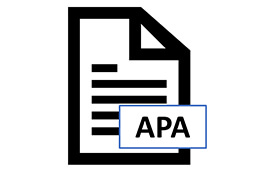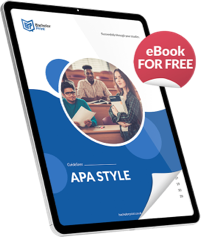
The APA Style, which sets forth the APA Format, is a widely accepted standard in academic writing, particularly in the social sciences. It dictates everything from the layout of your paper, the structure of your text, to the citation of sources, fostering consistency, credibility, and ease of understanding in scholarly communication. APA Format is a style of writing. Styles of writing refer to the format in which research papers structure their content. The goal of this format is to have an understandable method of communication due to its consistent rules.
Definition of APA format
APA stands for American Psychological Association. This body promotes research in psychology and has created guidelines to format research papers. The guidelines include how to step up the title page and cite sources used in a research paper. APA format is primarily used in the disciplines of social science and business. It is a standard for writing professional and academic papers.
APA format is intended to organize your content in a way that is similar across disciplines. This ensures that readers of your content can easily identify headings and content structure and find references. Other formats include MLA and Harvard referencing styles.
Choosing a font in APA Format
The format permits the use of sans serif fonts, including 10-point Lucida Sans Unicode, Calibri, and Arial. You may also use serif fonts like Times New Roman and Georgia. These types of fonts are recommended because they are legible for most readers.
Use a bolded font in APA format for your title, and use the same font size throughout your work. You may use a smaller font size in some instances, such as labeling fonts or inserting footnotes.
Note that these are the general guidelines as stipulated in the APA style guide. Professors may specify different fonts, and you should adhere to them.
Setting up the page header in APA format
The page header appears on the top margin on every page of your paper. Page headers usually consist of the page number alone. In some cases, it may feature an APA running head, especially in professional papers. The APA running head is a shortened version of the paper’s title, no more than 50 characters.
Leveling your headings and subheadings in APA format
APA Headings help your readers to identify sections in your paper. The most effective headlines are brief and concise as they draw the reader’s attention. There are five levels of headings in APA format:
Level: APA Format
- Title Case, Bold, Centered
- Title Case, Bold, Left Aligned
- Title Case, Bold, Italic, Left Aligned
- Title Face, Bold, Indented, Period.
- Title Face, Bold, Italics, Indented, Period.
Use more than one subsection heading within a section. Avoid labeling headings using numbers and use double-spacing.
| Heading Level | APA Heading Format |
| 1 |  |
| 2 |  |
| 3 |  |
| 4 |  |
| 5 |  |
Writing an abstract in APA format
An abstract in APA format refers to a comprehensive snapshot of your research paper. It highlights the research problem, the hypothesis, and the method of study. It comes after the title page and is typically less than 250 words.
Formatting the abstract
The APA abstract features a research paper’s page number and an APA running head. The “Abstract” label should be at the top of the page, centered and in boldface. Use a legible font and no more than 250 words to describe the research paper.
Writing the abstract
You can use the following questions to come up with good abstract ideas:
- What is the research problem?
- How did you study the variables in your research?
- What have you found out?
- What do you deduce from your findings?
Constructing the reference page in APA format
The APA reference page contains all the sources you have used in your paper. It comes at the end of your paper. Follow these guidelines for your APA reference page:
- Bold and center the title “References” on a new page
- Pick a legible font that’s consistent with the rest of the paper
- Use indentation and double spaces
Tables and figures in APA format
APA tables and figures are an essential part of a well-written research paper. They present the information visually and help to communicate your ideas more effectively.
Table format
APA format gives some general rules for creating tables and figures. These guiding principles can be modified depending on the type of data. Format your table as follows:
At the top of the table, label the table number:
- Use a short, bolded title
- Label rows and columns using clear labels
- Ensure numbers are in a consistent format and font
- Add any relevant additional notes at the bottom of the table
Figure format
Figures in APA format refer to diagrams, flowcharts, and photographs. To label figures correctly:
- Label the figure number on the top
- Add a brief title below the figure number
- Use colors where necessary to make your paper clear
FAQs
When using APA format in your paper, follow an in-text citation using the author-date structure. Mention the author’s first name and the year of publication, separated by a comma.
Example:
- (Jones, 1998)
Include all the sources on the APA reference page at the end of your paper.
If you are quoting directly from a book, include the page number at the end of the brackets. Use “p” for one page and “pp” if you cite multiple pages. Capitalize where necessary, such as writing authors’ names and other pronouns.
APA format requires a one-inch margin on all sides. The title page or cover page should be the first page of your essay. The components of the title page include the title of the paper, the instructor’s names, and the authors’ names. The title of your paper should be concise and not have any unnecessary phrases. Use headings across your work to make it easy to navigate and capture the main idea in each subheading.
A hanging indent is an indentation of the second and subsequent lines when referencing in APA format. It is used for formatting your document when creating bibliographies and reference pages.
Example:
- James, A. A. M., & Peterson, T. M. (2019). Presenting your findings: A
guide for investing. Washington, DC: American Psychological
Association.
To cite a book with more than one author, follow this format:
- Authors’ names: Michaels, P., & Maddison, M.
- Year: (1997)
- Title of the Book or Publication: Stories of yesterday
- Place of Publication: Austin, TX:
- Publisher: Wright Publications
Your reference should look like this:
- Michaels, P., & Maddison, M.(1997). Stories of yesterday. Austin, TX: Wright Publications
Secondary citations are citations already present in your source material. In such cases, it is advisable to find the original source and cite it directly from the source. If you cannot find the original source, use the phrase “as cited in” and mention the original source.
Example:
- According to Samuels, men have more spatial skills because of years of evolution as hunters (as cited in Roberts, 2009, p.76).
The rule of thumb when citing sources is to insert a citation when you use other people’s work. There is no defined limit on the number of citations to use in APA. However, ensure that people reading your paper can easily match your ideas to their sources.


